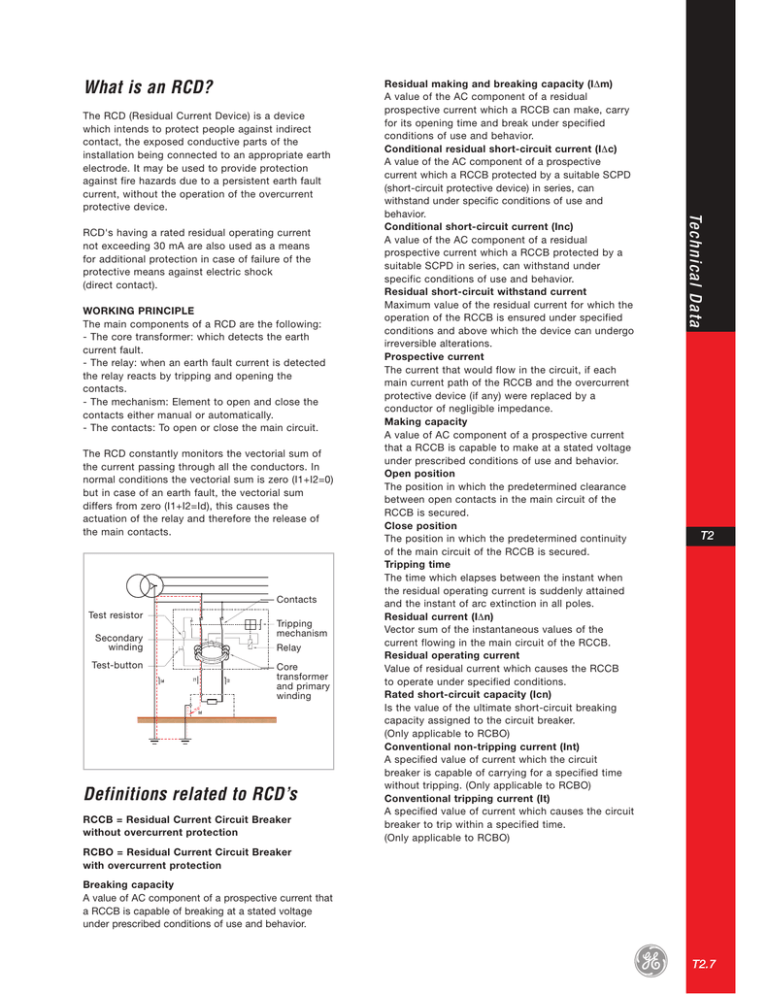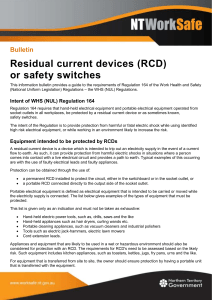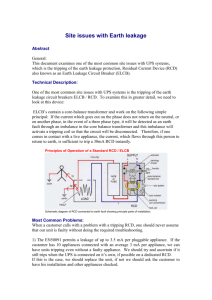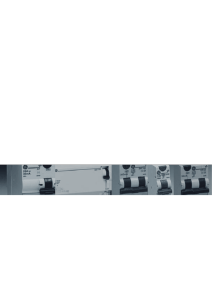Redline RCD Definitions
advertisement

What is an RCD? The RCD (Residual Current Device) is a device which intends to protect people against indirect contact, the exposed conductive parts of the installation being connected to an appropriate earth electrode. It may be used to provide protection against fire hazards due to a persistent earth fault current, without the operation of the overcurrent protective device. WORKING PRINCIPLE The main components of a RCD are the following: - The core transformer: which detects the earth current fault. - The relay: when an earth fault current is detected the relay reacts by tripping and opening the contacts. - The mechanism: Element to open and close the contacts either manual or automatically. - The contacts: To open or close the main circuit. The RCD constantly monitors the vectorial sum of the current passing through all the conductors. In normal conditions the vectorial sum is zero (I1+I2=0) but in case of an earth fault, the vectorial sum differs from zero (I1+I2=Id), this causes the actuation of the relay and therefore the release of the main contacts. Contacts Test resistor Secondary winding Test-button Tripping mechanism Relay Core transformer and primary winding Definitions related to RCD’s RCCB = Residual Current Circuit Breaker without overcurrent protection Technical Data RCD's having a rated residual operating current not exceeding 30 mA are also used as a means for additional protection in case of failure of the protective means against electric shock (direct contact). Residual making and breaking capacity (I6m) A value of the AC component of a residual prospective current which a RCCB can make, carry for its opening time and break under specified conditions of use and behavior. Conditional residual short-circuit current (I6c) A value of the AC component of a prospective current which a RCCB protected by a suitable SCPD (short-circuit protective device) in series, can withstand under specific conditions of use and behavior. Conditional short-circuit current (Inc) A value of the AC component of a residual prospective current which a RCCB protected by a suitable SCPD in series, can withstand under specific conditions of use and behavior. Residual short-circuit withstand current Maximum value of the residual current for which the operation of the RCCB is ensured under specified conditions and above which the device can undergo irreversible alterations. Prospective current The current that would flow in the circuit, if each main current path of the RCCB and the overcurrent protective device (if any) were replaced by a conductor of negligible impedance. Making capacity A value of AC component of a prospective current that a RCCB is capable to make at a stated voltage under prescribed conditions of use and behavior. Open position The position in which the predetermined clearance between open contacts in the main circuit of the RCCB is secured. Close position The position in which the predetermined continuity of the main circuit of the RCCB is secured. Tripping time The time which elapses between the instant when the residual operating current is suddenly attained and the instant of arc extinction in all poles. Residual current (I6n) Vector sum of the instantaneous values of the current flowing in the main circuit of the RCCB. Residual operating current Value of residual current which causes the RCCB to operate under specified conditions. Rated short-circuit capacity (Icn) Is the value of the ultimate short-circuit breaking capacity assigned to the circuit breaker. (Only applicable to RCBO) Conventional non-tripping current (Int) A specified value of current which the circuit breaker is capable of carrying for a specified time without tripping. (Only applicable to RCBO) Conventional tripping current (It) A specified value of current which causes the circuit breaker to trip within a specified time. (Only applicable to RCBO) T2 RCBO = Residual Current Circuit Breaker with overcurrent protection Breaking capacity A value of AC component of a prospective current that a RCCB is capable of breaking at a stated voltage under prescribed conditions of use and behavior. T2.7 Redline People Protection RCD’s classification acc. EN/IEC 61008/61009 RCD’s may be classified according to: • The behavior in presence of dc current (types for general use). - Type AC - Type A • The time-delay (in presence of residual current) - RCD’s without time delay: type for general use - RCD’s with time delay: type S for selectivity Type AC The type AC RCDs are designed to release with sinusoidal residual currents which occur suddenly or slowly rise in magnitude. Type A Certain devices during faults can be the source of non-sinusoidal earth leakage currents (DC components) due to the electronic components e.g.: diodes, thyristors….. The type A RCD’s are designed to ensure that under this conditions the residual current devices operate on sinusoidal residual current and also with pulsating direct current(*) which occur suddenly or slowly rise in magnitude. (*) Pulsating direct current: current of pulsating wave form which assumes, in each period of the rated power frequency, the value 0 or a value not exceeding 0,006 A dc during one single interval of time, expressed in angular measure of at least 150º. Residual current Tripping time 0.5xI6n 1 xI6n 2 xI6n 5 xI6n t=' t = < 300ms t = < 150ms t = < 40ms 1. For sinusoidal residual current 2. For residual pulsating direct current Residual current Tripping time max.6mA min.150° 0.5 x l6n 1 x l6n 2 x l6n 5 x l6n t=' t = < 300ms t = < 150ms t = ) 40ms max.6mA At point of wave 0° 0.35xI6n 1.4 xI6n 2.8 xI6n 7 xI6n t=' t = < 300ms t = < 150ms t = < 40ms At point of wave 90° 0.25xI6n 1.4 xI6n 2.8 xI6n 7 xI6n t=' t = < 300ms t = < 150ms t = < 40ms At point of wave 135° 0.11xI6n 1.4 xI6n 2.8 xI6n 7 xI6n t=' t = < 300ms t = < 150ms t = < 40ms min.150° T2 Type A Tripping curve type AC Type AC Tripping curve type A T2.8 Selectivity Vertical selectivity In an installation with RCD’s installed in series we need to pay special attention to the vertical selectivity, in order to ensure that in case of earth leakage only the RCD which is immediately upstream of the fault point will operate. Selectivity is ensured when the characteristic time/current of the upstream RCD (A) is above the characteristic time /current of the downstream RCD (B). To obtain vertical selectivity we should take into consideration the following parameters: The RCD placed at the top of the installation shall be Type S. The residual operating current of the RCCB installed downstream shall have a lower residual operating current than the RCD installed upstream according to: I n downstream < I Technical Data Type S S RCD’s type A or AC have instantaneous tripping. In order to provide full people protection in vertical installation (no class II) with more than one circuit, as well as to ensure the service in the installation in case of earth leakage in one of the circuits or to avoid unwanted tripping because of harmonics, high connection currents due to the use of motors, reactive loads, or variable speed drivers, we need to use selective RCD’s at the top of the installation. Any RCD type S is selective to any other instantaneous RCD installed downstream with lower sensitivity. n upstream/3 Vertical selectivity RCCB 300mA selective ➀ ➁ RCCB selective RCCB 100mA RCCB 30mA RCCB instantaneous T2 Horizontal selectivity To have horizontal selectivity in an installation with RCD’s we need to avoid the use of RCD in cascading. Every single circuit of the installation shall be provided with a RCD of the appropriate residual operating current. The connection between the back-up protective device and the RCD must be short-circuit proof (Class II). Horizontal selectivity Short-circuit proof RCCB 30mA RCCB 30mA T2.9 Redline People Protection Nuisance tripping Type AI (High immunity to nuisance tripping) Electric equipment incorporates more and more electronic components which causes nuisance tripping to the conventional 30mA RCD’s type A or AC (always in the most critical moment like weekends, areas with no people presence…) due to overvoltages or high frequency currents produced by atmospheric disturbances, lighting equipment (electronic balasters), computers, appliances, connections to long cables which induce a high capacity to ground, etc. Some times the filter incorporated on the standard RCD’s type A or AC which are protected to prevent nuisance tripping against current peak up to 250 A 8/20 µs, does not avoid 100% unwanted tripping. Therefore GE Power Controls has developed a new RCD generation which protects against nuisance tripping of peak currents up to 5000 A 8/20 µs. Installations with either lighting equipment incorporating electronic balasters or computers. The most typical problem in these installations is the tripping of the RCD when switching the equipment ON-OFF. It is recommended that, in case several devices are installed in the same line, the sum of all leakages shall not exceed 1/3 l6n since any disturbance in the line can trip the RCD. For this kind of installation it is recommended to split up circuits or to use type AI RCD’s. T2 RCD’s type AI or ACI have a tripping characteristic according to EN/IEC 61008/61009. All RCD’s have a high level of immunity to transient currents, against current impulses of 8/20 µs according to EN/IEC 61008/61009 and VDE 0664.T1 Type Type Type Type A, AC .....................250 S ..........................3000 Ai .........................3000 Si .........................5000 Curve 8/20 µs 100% 90% 50% 10% 0 8us 20us T2.10 A A A A 8/20 8/20 8/20 8/20 µs µs µs µs RCD’s have a high level of immunity against ring wave currents of high frequency according to EN/IEC 61008/61009 Curve 0.5 µs - 100 kHz - 200 A EN/IEC 61008/61009



